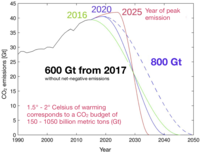
Photo from wikipedia
Abstract Methane (CH 4 ) emissions and carbon uptake in temperate freshwater wetlands act in opposing directions in the context of global radiative forcing. Large uncertainties exist for the rates… Click to show full abstract
Abstract Methane (CH 4 ) emissions and carbon uptake in temperate freshwater wetlands act in opposing directions in the context of global radiative forcing. Large uncertainties exist for the rates of CH 4 emissions making it difficult to determine the extent that CH 4 emissions counteract the carbon sequestration of wetlands. Urban temperate wetlands are typically small and feature highly heterogeneous land cover, posing an additional challenge to determining their CH 4 budget. The data analysis approach we introduce here combines two different CH 4 flux measurement techniques to overcome scale and heterogeneity problems and determine the overall CH 4 budget of a small, heterogeneous, urban wetland landscape. Temporally intermittent point measurements from non-steady-state chambers provided information about patch-level heterogeneity of fluxes, while continuous, high temporal resolution flux measurements using the eddy-covariance (EC) technique provided information about the temporal dynamics of the fluxes. Patch-level scaling parameterization was developed from the chamber data to scale eddy covariance data to a ‘fixed-frame’, which corrects for variability in the spatial coverage of the eddy covariance observation footprint at any single point in time. By combining two measurement techniques at different scales, we addressed shortcomings of both techniques with respect to heterogeneous wetland sites. We determined that fluxes observed by the two methods are statistically similar in magnitude when brought to the same temporal and spatial scale. We also found that open-water and macrophyte-covered areas of the wetland followed similar phenological cycles and emitted nearly equivalent levels of CH 4 for much of the year. However, vegetated wetland areas regularly exhibited a stronger late-summer emission peak, possibly due to CH 4 transport through mature vegetation vascular systems. Normalizing the eddy covariance data to a fixed-frame allowed us to determine the seasonal CH 4 budget of each patch and the overall site. Overall, the macrophyte areas had the largest CH 4 fluxes followed by the open water areas. Uncertainties in the final CH 4 budget included spatial heterogeneity of CH 4 fluxes, the tower footprint, measurement in the data to be scaled, and gap-filling. Of these, the spatial placement of the chambers provided the largest source of uncertainty in CH 4 estimates. This reinforces the need to utilize site-level measurements when estimating CH 4 fluxes from wetlands as opposed to using only up-scaled point measurements.
Journal Title: Agricultural and Forest Meteorology
Year Published: 2017
Link to full text (if available)
Share on Social Media: Sign Up to like & get
recommendations!